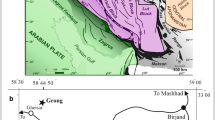Abstract
Vertical and horizontal thin-sections of new material of Keratoisis from the Pliocene “Trubi” (Sicily) suggest that larger and smaller, branched and unbranched internodes belong all to a single species Keratoisis melitensis (GOLDFUSS, 1826) of which Keratoisis peloritana (SEQUENZA, 1864) is a junior synonym.
Five different types of sklerites were found within the same deposits and prove a wide spectrum of gorgonaceans during the Pliocene in the Mediterranean Sea. Root, internodes and sklerites of the coral suggest a paleodepth of 100-200 m for the Trubi.
Kurzfassung
Der Fund eines Fufies von Keratoisis melitensis (GOLDFUSS, 1826) in den Trubi legt nahe, die zahlreicnen grofien und kleinen, verzweigten und unverzweigten Internodien von der gleichen Fundstelle als zu einer an Ort ansassigen Population einer einzigen Art zu betrachten. Aufgrund der konzentrischen Wachstumsgeometrie der Internodien in Langs- und Querschnitten wird die gemeinsame Grundmorphologie dicker und diinner Internodien sichtbar. Darauf wird die Synonymie von Keratoisis peloritana (Sequenza, 1864) und Keratoisis melitensis (Goldfuss, 1826) begriindet. Fiinf verschiedene Grundtypen von Oktokorallen-Skleriten wurden in den gleichen Ablagerungen gefunden und belegen ein breites Faunenspektrum der pliozanen Gorgonien im Mittelmeer. Sklerite, Kalkkrusten auf den Internodien und die Morphologie der Wurzel sprechen fur eine Ablagerungstiefe der Trubi von 100-200 m.
Similar content being viewed by others
Literatur
Baster, J. (1762): Opuscula subseciva, observationes miscellaneas de animaliculis. —1: 1–150, Taf. 1-16, Haarlem.
Bayer, F. M;Grasshoff, M. &Verseveldt, J. (1983): Illustrated trilingual glossary of morphological and anatomical terms applied to Octocorallia. — 75 S.; Leiden.
Blainville, H. M. D. DE (1834): Manuel ďactinologie ou de zoophytologie. — 1–617, Taf. 1–91; Paris.
Carpine, C. &Grasshoff, M. (1975): Les Gorgonaires de la Mediterranee. — Bull. Inst. Océanographique,71: no. 1430, 140 S., 62 Fig., Monaco.
Geronimo, I. DI (1979): II Pleistocene in facies batiale die Valle Palione (Grammichele, Catania). — Boll. malacologico,15 (5/6): 85–156; Mailand.
Goldfuss, G. A. (1826): Petrefacta Germaniae,1 (1): 1–76, Taf. 1-7; Düsseldorf.
Grasshoff, M. (1980): Isididae aus dem Pliozän und Pleistozän von Sizilien (Cnidaria: Octocorallia). — Senckenbergiana lethaea60 (4/6): 435–447; Frankfurt a. M.
Grasshoff, M. &Zibrowius, H. (1983): Kalkkrusten auf Achsen von Hornkorallen, rezent und fossil. — Senckenbergiana maritima,15 (4/6): 11–145; Frankfurt a. M.
Knorr, G. W. (in:Walch, J. E. I., Hrsg.) (1771): Die Naturgeschichte der Versteinerungen zur Erläuterung der knorrischen Sammlung von Merkwürdigkeiten der Natur,3: 1–235, 84 Taf.; Nürnberg.
Lamouroux, J. V. F. (1812): Sur la classivication des polypiers corralligenes non entierement pierreux. — Nouv. Bull. Soc. Sci.,3: 181–188; Paris.
Langer, M. R. (1985): Geologie der Halbinsel von Milazzo (Sizilien). — Unveroff. Dipl.-Arb., Teil2: 53–76; Freiburg i. Brsg.
Lipparini, T., Malatesta, A., Nicosia, M. L. &Valdinucci, A. (1955): Contributi alia conoscenza della faune Neogeniche e Quaternarie della Sicilia. V. Pliocene e Quaternario del Capo Milazzo in Sicilia. — Boll. Serv. Geol. ďItalia,77 (4/5): 579–604; Rom.
Michelotti, G. (1847): Description des fossiles des Terraines miocenes de ľItalie septentrionale: 1–408, Taf. 1–17; Leiden.
Milne-edwards, H. &Haime, J. (1857): Histoire naturelle des coralliaires ou polypes proprement dits. —1: 1–326; Atlas: 1–11, Taf. A1–G2; Paris.
Pictet, F.-J. (1857): Traité de paléontologie,4: 1–768; Paris.
Ruggieri, G. &Greco, A. (1965): Studi geologici e paleontologici su Capo Milazzo con particolare riguardo al Milazziano. — Geologica Romana,4: 41–88, Abb. 1–4, 11 Taf.; Rom.
Scheuchzer, J. C. (1723): Herbarium diluvianum.—Ed. nov.: 1–119, Taf. l–14;Lugdunum, Batav(Vander Aa).
Scilla, A. (1759): De corporibus marinis lapidescentibus quae defossa reperiuntur, 1–72, Taf. 1–28; Rom.
Sequenza, G. (1864): Disquisizioni paleontologiche inforno ai corallarii fossili delle Rocce Terziatie del distretto di Messina. — Mem. reale Accad. Sci. Torino: 399-560, Taf. 1–15; Turin.
Wright, E. P. (1869): On a new genus of Gorgonidae from Portugal. — Ann. and Mag. nat. Hist.,3 (4): 23–26, Abb. 1-3; London.
Author information
Authors and Affiliations
Rights and permissions
About this article
Cite this article
Langer, M. Haftorgan, Internodien und Sklerite von Keratoisis melitensis (Goldfuss, 1826) (Octocorallia) in den pliozanen Foraminiferenmergeln (»Trubi«) von Milazzo (Sizilien). Paläont. Z. 63, 15–24 (1989). https://doi.org/10.1007/BF02989523
Received:
Issue Date:
DOI: https://doi.org/10.1007/BF02989523




